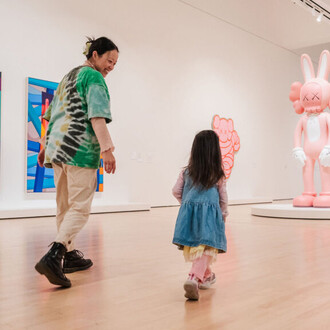Based on the Talmudic study principle of havruta—the study of religious texts by people in pairs—In That Case at The CJM encourages learning through fellowship for Bay Area artists, established professionals, museum staff, and the entire CJM community. Capitalizing on the unique Jewish perspective inherent to The Museum, this program takes the practice of havruta and repurposes it for the contemporary art community. Each local artist invited to participate in In That Case is given the opportunity to work with an established writer, scientist, thinker, or academic in a field of their choosing. The resulting collaborations are presented in the Sala Webb Education Center.
The relationship between dance and visual arts has been an ongoing theme in the field at least since Edgar Degas’ iconic ballerina paintings and bronzes. Artists such as Pablo Picasso and Henri Matisse designed ballet sets for the early twentieth century Ballets Russes; in addition, there has been a mutual influence between dance and performance art, epitomized by the innovative work of the late German choreographer Pina Bausch. These collaborative projects echo The CJM’s Havruta program’s goals.
The sixth iteration of the In That Case series brings together a Bay Area visual artist, Kota Ezawa, and the San Francisco born and raised contemporary dancer, James Kirby Rogers, now part of The Houston Ballet II.
In his practice, Ezawa often reworks images from popular culture, film, and art history, stripping them down to their core elements. His simplified versions remain easily recognizable and potent, maintaining a keen awareness of how images shape our experience and memory of events.
For their collaboration, Much Ado About Nothing, Ezawa produced a video animation based on Rogers’ choreography and movements, which he performed in front of Ezawa’s camera. As the movements repeat through multiple screens, removed from a larger context, the choreography—initially unknown to the audience—becomes at once familiar and mechanical to their eyes.
Representing movement is a major challenge for both the visual arts and popular culture, and especially film. Constant experimentation can be traced from Eadweard Muybridge’s nineteenth century motion studies to contemporary 3D motion capture computer programs, and including dancers on pop music videos. Ezawa’s and Rogers’ project takes inspiration from filmic dances like Fred Astaire’s shadow dance sequence in Swing Time (1936) and the collaboration between video artist Nam June Paik and choreographer Merce Cunningham. A synthesis of two art forms, their collaboration blurs the line between tangible human movements and the imaginative powers enabled by digital animation.
















